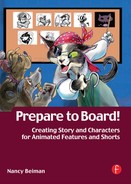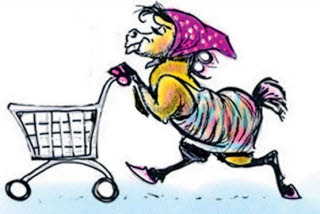“Just be sure you don’t use the words ‘old- fashioned!’”
—Roy Disney in email to author, 2005
This book describes visual storytelling and design methods developed during the “Golden Age of Animation” and still in use today, as Roy Disney pointed out to me. Some people say that story is the only thing that matters in animated film. I agree. Good animation and good design never saved a bad story. Strong characters can make a weak story tolerable and a good story better, but characters develop within a story context. Each depends upon the other.
The first part of this book will concern itself with developing story content. Technique will be discussed in the second part, and the third part will deal with the presentation of the story and artwork before an audience.
Story works out of and depends on your experience and skill. There is no software that will draw good storyboards for you.
Memorable characters exist in every medium. The technology may vary but basic design principles remain constant. A well-drawn character will translate into a well-designed puppet or computer-generated imagery (CGI) character. The principles described in the book’s character design sections are intended for use in all media.
Eighty percent of an animated film’s production time is spent in developing the story, art direction, and designs for the characters. The other 20 percent is spent on the actual animation production and post-production.
Outlines, scripts, and storyboards for television, feature length, and short animated films differ greatly from one another. Feature and short animated films are more popular than ever before. Yet their production differs from that of a television show. Most films and television shows start with a script. While scripts are important on longer animated films, they are not necessarily written at the start of the production. Animated short films may be created without any script at all.
This book will concentrate on visual scriptwriting.
There is a danger of concentrating solely on technique—the ’how’—of animation (squash and stretch, how to turn a head, how to do a walk, how to run a program) and considering story and context—the ‘why’—almost an afterthought.
This is putting the cart before the horse.
Animation and story are not mutually exclusive. Good stories and appealing characters will transcend their technology. Professional animators and hardcore fans will notice minor inconsistencies in a film. If the story is good, and the characters appealing, the audience will overlook these same inconsistencies.
Animated characters are often able to defy the laws of gravity and physics, but animated stories cannot defy the laws of common sense. The animated film must create its own reality. We must immediately comprehend the power of the poisoned apple, or the character weakness of a lion cub or a “Beast.” Boredom and frustration results if a character’s properties change midpicture solely to accommodate weak storytelling.
It is not enough to rely on the soundtrack to carry the story. Ideally, dialogue in an animated film complements the visuals and not vice versa. The very best character animation can still tell the story with the soundtrack turned off. It should illustrate a story that is worth telling.
Good writing leaves a lot to the reader’s imagination. Each reader creates their individual pictures of the settings and the characters’ appearances based on information that the author provides. Author and reader collaborate to create the story. An animated film distributes a few artists’ fantasies to large masses of people. We should try to make them good ones.
Animated actors are harder to watch than human actors. The animator must convince the audience to suspend disbelief and accept imaginary characters as living beings with real problems. Most live actors don’t have this problem since we accept them as ‘real’ from the start. Animation brings the inanimate to life—the life is not there to begin with.
A good character can be developed from a story. A good character can inspire the story. Story is the most important thing in animation, but creating appealing characters to tell it—animated characters—is the other most important thing. Which element should the animator develop first?
Which comes first?
Character and story reinforce one another and are created concurrently during preproduction. They will be discussed in all three parts of this book since developing one in the absence of the other is like making an omelet without eggs.

Character and story develop simultaneously!
Development is a marvelous creative process in which the journey is as important as the destination. It’s what you do, and also how you do it!
I’ve always felt that animators are not merely “actors with pencils,” as the cliché goes. That term does not begin to cover what an animator really does.
We bring the inanimate to life.
We create universes.
We are magicians.
Nancy Beiman
Rochester, New York
August, 2006


